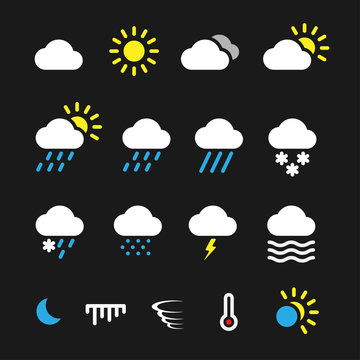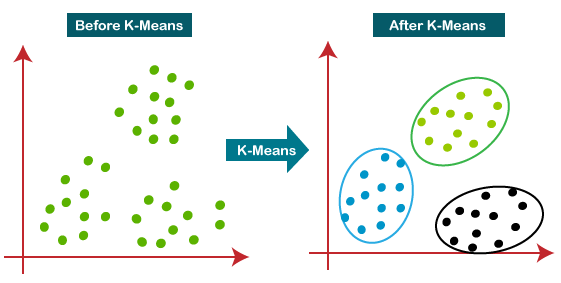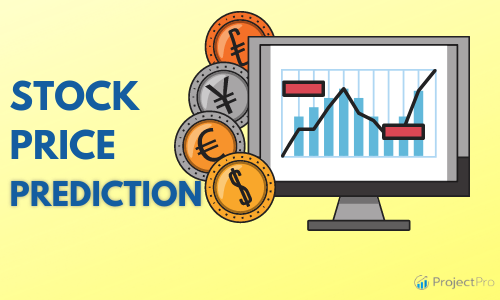blogs
Weather Forecasting Weather forecasting is the task of forecasting weather conditions for a given location and time. With the use of weather data and algorithms, it is possible to predict weather conditions for the next n number of days. For forecasting weather using Python, we need a dataset containing historical weather data based on a particular location. I found a dataset on Kaggle based on the Daily weather data of New Delhi. We can use this dataset for the task of weather forecasting. You can download the dataset from here. In the section below, you will learn how we can analyze and forecast the weather using Python. Analyzing Weather Data using Python Now let’s start this task by importing the necessary Python libraries and the dataset we need: 1 import pandas as pd import numpy as np import matplotlib.pyplot as plt import seaborn as sns import plotly.express as px data = pd.read_csv("DailyDelhiClimateTrain.csv") print(data.head()) date meantemp humidity wind_speed meanpressure 0 2013-01-01 10.000000 84.500000 0.000000 1015.666667 1 2013-01-02 7.400000 92.000000 2.980000 1017.800000 2 2013-01-03 7.166667 87.000000 4.633333 1018.666667 3 2013-01-04 8.666667 71.333333 1.233333 1017.166667 4 2013-01-05 6.000000 86.833333 3.700000 1016.500000 Let’s have a look at the descriptive statistics of this data before moving forward: 1 print(data.describe()) meantemp humidity wind_speed meanpressure count 1462.000000 1462.000000 1462.000000 1462.000000 mean 25.495521 60.771702 6.802209 1011.104548 std 7.348103 16.769652 4.561602 180.231668 min 6.000000 13.428571 0.000000 -3.041667 25% 18.857143 50.375000 3.475000 1001.580357 50% 27.714286 62.625000 6.221667 1008.563492 75% 31.305804 72.218750 9.238235 1014.944901 max 38.714286 100.000000 42.220000 7679.333333 Now let’s have a look at the information about all the columns in the dataset: 1 print(data.info()) <class 'pandas.core.frame.DataFrame'> RangeIndex: 1462 entries, 0 to 1461 Data columns (total 5 columns): # Column Non-Null Count Dtype --- ------ -------------- ----- 0 date 1462 non-null object 1 meantemp 1462 non-null float64 2 humidity 1462 non-null float64 3 wind_speed 1462 non-null float64 4 meanpressure 1462 non-null float64 dtypes: float64(4), object(1) memory usage: 57.2+ KB The date column in this dataset is not having a datetime data type. We will change it when required. Let’s have a look at the mean temperature in Delhi over the years: 1 figure = px.line(data, x="date", y="meantemp", title='Mean Temperature in Delhi Over the Years') figure.show() Now let’s have a look at the humidity in Delhi over the years: 1 figure = px.line(data, x="date", y="humidity", title='Humidity in Delhi Over the Years') figure.show() Now let’s have a look at the wind speed in Delhi over the years: figure = px.line(data, x="date", y="wind_speed",title='Wind Speed in Delhi Over the Years') figure.show() Till 2015, the wind speed was higher during monsoons (August & September) and retreating monsoons (December & January). After 2015, there were no anomalies in wind speed during monsoons. Now let’s have a look at the relationship between temperature and humidity: 1 figure = px.scatter(data_frame = data, x="humidity",y="meantemp", size="meantemp", trendline="ols", title = "Relationship Between Temperature and Humidity") figure.show() There’s a negative correlation between temperature and humidity in Delhi. It means higher temperature results in low humidity and lower temperature results in high humidity. Analyzing Temperature Change Now let’s analyze the temperature change in Delhi over the years. For this task, I will first convert the data type of the date column into datetime. Then I will add two new columns in the dataset for year and month values. Here’s how we can change the data type and extract year and month data from the date column: 1 data["date"] = pd.to_datetime(data["date"], format = '%Y-%m-%') data['year'] = data['date'].dt.year data["month"] = data["date"].dt.month print(data.head()) date meantemp humidity wind_speed meanpressure year month 0 2013-01-01 10.000000 84.500000 0.000000 1015.666667 2013 1 1 2013-01-02 7.400000 92.000000 2.980000 1017.800000 2013 1 2 2013-01-03 7.166667 87.000000 4.633333 1018.666667 2013 1 3 2013-01-04 8.666667 71.333333 1.233333 1017.166667 2013 1 4 2013-01-05 6.000000 86.833333 3.700000 1016.500000 2013 1 Now let’s have a look at the temperature change in Delhi over the years: 1 plt.style.use('fivethirtyeight') plt.figure(figsize=(15, 10)) plt.title("Temperature Change in Delhi Over the Years") sns.lineplot(data = data, x='month', y='meantemp', hue='year') plt.show() Although 2017 was not the hottest year in the summer, we can see a rise in the average temperature of Delhi every year. Forecasting Weather using Python Now let’s move to the task of weather forecasting. I will be using the Facebook prophet model for this task. The Facebook prophet model is one of the best techniques for time series forecasting. If you have never used this model before, you can install it on your system by using the command mentioned below in your command prompt or terminal: pip install prophet The prophet model accepts time data named as “ds”, and labels as “y”. So let’s convert the data into this format: 1 forecast_data = data.rename(columns = {"date": "ds", "meantemp": "y"}) print(forecast_data) ds y humidity wind_speed meanpressure year month 0 2013-01-01 10.000000 84.500000 0.000000 1015.666667 2013 1 1 2013-01-02 7.400000 92.000000 2.980000 1017.800000 2013 1 2 2013-01-03 7.166667 87.000000 4.633333 1018.666667 2013 1 3 2013-01-04 8.666667 71.333333 1.233333 1017.166667 2013 1 4 2013-01-05 6.000000 86.833333 3.700000 1016.500000 2013 1 ... ... ... ... ... ... ... ... 1457 2016-12-28 17.217391 68.043478 3.547826 1015.565217 2016 12 1458 2016-12-29 15.238095 87.857143 6.000000 1016.904762 2016 12 1459 2016-12-30 14.095238 89.666667 6.266667 1017.904762 2016 12 1460 2016-12-31 15.052632 87.000000 7.325000 1016.100000 2016 12 1461 2017-01-01 10.000000 100.000000 0.000000 1016.000000 2017 1 [1462 rows x 7 columns] Now below is how we can use the Facebook prophet model for weather forecasting using Python: 1 from prophet import Prophet from prophet.plot import plot_plotly, plot_components_plotly model = Prophet() model.fit(forecast_data) forecasts = model.make_future_dataframe(periods=365) predictions = model.predict(forecasts) plot_plotly(model, predictions) So this is how you can analyze and forecast the weather using Python. Summary Weather forecasting is the task of forecasting weather conditions for a given location and time. With the use of weather data and algorithms, it is possible to predict weather conditions for the next n number of days. I hope you liked this article on Weather Analysis and Forecasting using Python. Feel free to ask valuable questions in the comments section below.
Introduction Every bank wants to hold there customers for sustaining their business so the Multinational bank. Below is the customer data of account holders at Multinational Bank and the aim of the data will be predicting the Customer Churn. What is bank Customer Churn Prediction? Businesses tend to focus on voluntary churn (where customers actively choose to leave your service) but involuntary churn (where they leave due to a failure that is outside of their control) Is the most common type, and the most easily addressed (if you can fix it proactively, before the failure). Churn Prediction Model is a predictive model that calculates, on an individual customer basis, the likelihood (or susceptibility) that a customer will stop doing business with the company. It gives you an indication, for each customer at any given time, of how high the risk is that you will lose them in the future.Churn prediction means detecting which customers are likely to leave a service or to cancel a subscription to a service. It is a critical prediction for many businesses because acquiring new clients often costs more than retaining existing ones. Bank customer churn prediction is fundamentally a classification problem where we build a classifier to predict whether or not a customer will churn. The target variable of this classification problem is categorical (churn vs. no churn), while the high-level analysis is numerical (the churn rate). Line charts can be used to show churn over time. Bar charts are used to show churn by different categories or can be used as an alternative to line charts to show churn over time. Stacked bar charts allow you to add another dimension to a bar chart, letting you to see in more detail where the churn was coming from
Context This data set is created only for the learning purpose of the customer segmentation concepts , also known as market basket analysis . I will demonstrate this by using unsupervised ML technique (KMeans Clustering Algorithm) in the simplest form. Content You are owing a supermarket mall and through membership cards , you have some basic data about your customers like Customer ID, age, gender, annual income and spending score. Spending Score is something you assign to the customer based on your defined parameters like customer behavior and purchasing data. Problem Statement You own the mall and want to understand the customers like who can be easily converge [Target Customers] so that the sense can be given to marketing team and plan the strategy accordingly. Inspiration By the end of this case study , you would be able to answer below questions. 1- How to achieve customer segmentation using machine learning algorithm (KMeans Clustering) in Python in simplest way. 2- Who are your target customers with whom you can start marketing strategy [easy to converse] 3- How the marketing strategy works in real world KMeans Clustering K-means clustering is one of the simplest and popular unsupervised machine learning algorithms. You’ll define a target number k, which refers to the number of centroids you need in the dataset. A centroid is the imaginary or real location representing the center of the cluster. Every data point is allocated to each of the clusters through reducing the in-cluster sum of squares. In other words, the K-means algorithm identifies k number of centroids, and then allocates every data point to the nearest cluster, while keeping the centroids as small as possible. The ‘means’ in the K-means refers to averaging of the data; that is, finding the centroid. About the dataset This input file contains the basic information (ID, age, gender, income, spending score) about the customers of a mall. Spending Score is something you assign to the customer based on your defined parameters like customer behavior and purchasing data.
This is a simple approach to the historic AAPL stock price data using LSTM, the prediction is fairly close to the real data . Please let me know what would you change to make it more accurate, I appreciate any comment or suggestion.
The problem that we are going to solve here is that given a set of features that describe a house in Boston, our machine learning model must predict the house price. To train our machine learning model with boston housing data, we will be using scikit-learn’s boston dataset. In this dataset, each row describes a boston town or suburb. There are 547 rows and 13 attributes (features) with a target column (price). https://archive.ics.uci.edu/ml/machine-learning-databases/housing/housing.names https://github.com/KARIM-MADRID/PY_ML_Houseprediction_Deployment
Market segmentation is the activity of dividing a broad consumer or business market, normally consisting of existing and potential customers, into sub-groups of consumers based on some type of shared characteristics Companies employing customer segmentation operate under the fact that every customer is different and that their marketing efforts would be better served if they target specific, smaller groups with messages that those consumers would find relevant and lead them to buy something. Companies also hope to gain a deeper understanding of their customers' preferences and needs with the idea of discovering what each segment finds most valuable to more accurately tailor marketing materials toward that segment. Malls or shopping complexes are often indulged in the race to increase their customers and hence making huge profits. To achieve this task machine learning is being applied by many stores
Historical Hourly Weather Data Who amongst us doesn't small talk about the weather every once in a while? The goal of this dataset is to elevate this small talk to medium talk. Just kidding, I actually originally decided to collect this dataset in order to demonstrate basic signal processing concepts, such as filtering, Fourier transform, auto-correlation, cross-correlation, etc…, (for a data analysis course I'm currently preparing). I wanted to demonstrate these concepts on signals that we all have intimate familiarity with and hope that this way these concepts will be better understood than with just made up signals. The weather is excellent for demonstrating these kinds of concepts as it contains periodic temporal structure with two very different periods (daily and yearly
About Dataset The data was collected and made available by “National Institute of Diabetes and Digestive and Kidney Diseases” as part of the Pima Indians Diabetes Database. Several constraints were placed on the selection of these instances from a larger database. In particular, all patients here belong to the Pima Indian heritage (subgroup of Native Americans), and are females of ages 21 and above. We’ll be using Python and some of its popular data science related packages. First of all, we will import pandas to read our data from a CSV file and manipulate it for further use. We will also use numpy to convert out data into a format suitable to feed our classification model. We’ll use seaborn and matplotlib for visualizations. We will then import Logistic Regression algorithm from sklearn. This algorithm will help us build our classification model. Lastly, we will use joblib available in sklearn to save our model for future use.











